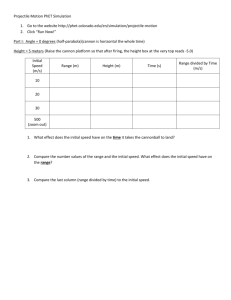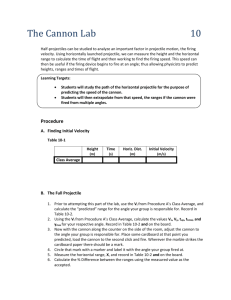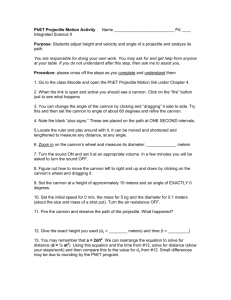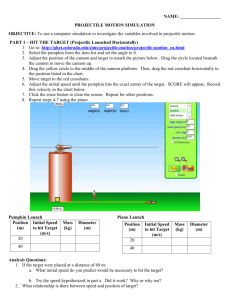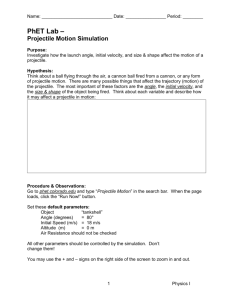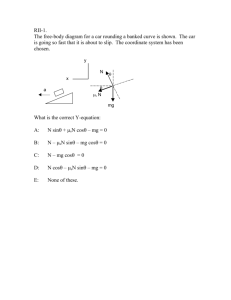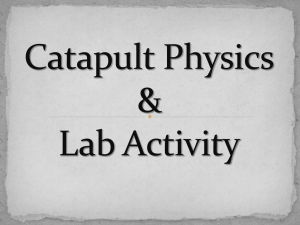doc - UCF Physics
advertisement
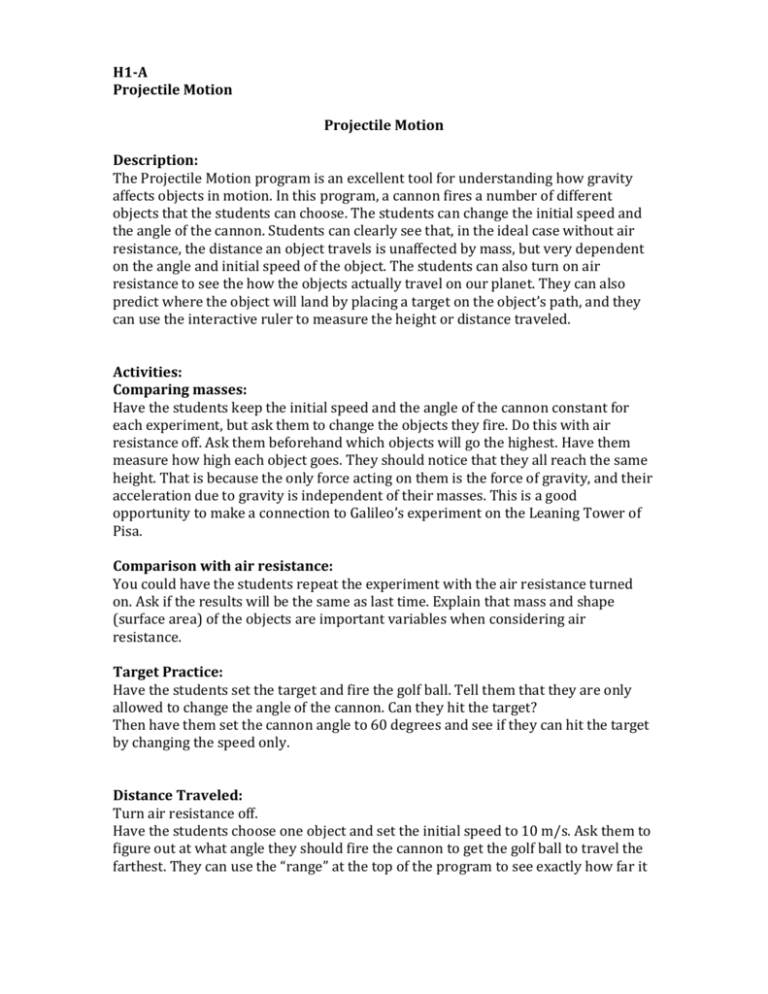
H1-A Projectile Motion Projectile Motion Description: The Projectile Motion program is an excellent tool for understanding how gravity affects objects in motion. In this program, a cannon fires a number of different objects that the students can choose. The students can change the initial speed and the angle of the cannon. Students can clearly see that, in the ideal case without air resistance, the distance an object travels is unaffected by mass, but very dependent on the angle and initial speed of the object. The students can also turn on air resistance to see the how the objects actually travel on our planet. They can also predict where the object will land by placing a target on the object’s path, and they can use the interactive ruler to measure the height or distance traveled. Activities: Comparing masses: Have the students keep the initial speed and the angle of the cannon constant for each experiment, but ask them to change the objects they fire. Do this with air resistance off. Ask them beforehand which objects will go the highest. Have them measure how high each object goes. They should notice that they all reach the same height. That is because the only force acting on them is the force of gravity, and their acceleration due to gravity is independent of their masses. This is a good opportunity to make a connection to Galileo’s experiment on the Leaning Tower of Pisa. Comparison with air resistance: You could have the students repeat the experiment with the air resistance turned on. Ask if the results will be the same as last time. Explain that mass and shape (surface area) of the objects are important variables when considering air resistance. Target Practice: Have the students set the target and fire the golf ball. Tell them that they are only allowed to change the angle of the cannon. Can they hit the target? Then have them set the cannon angle to 60 degrees and see if they can hit the target by changing the speed only. Distance Traveled: Turn air resistance off. Have the students choose one object and set the initial speed to 10 m/s. Ask them to figure out at what angle they should fire the cannon to get the golf ball to travel the farthest. They can use the “range” at the top of the program to see exactly how far it H1-A Projectile Motion goes. They should find that the angles closest to 45 degrees make the object travel the farthest. Important Lessons: Ask the students what variables are important in determining how far each object travels (without air resistance). They should be able to recognize that they only needed to change the angle and the initial speed. H1-A Projectile Motion Name _____________________________________ Date___________________ Projectile Motion Worksheet 1. Without any air resistance, if you fire a piano and a golf ball out of a cannon using the same initial speed and angle, which do you think would go higher? Which would go farther? 2. Play around with the different options for the cannon. What are the different variables that affect the distance or height of each object when you fire them? 3. Set the angle to 60 degrees and the Initial Speed to 10 m/s. Fire each of the following objects and fill in the results. You will need to use the virtual ruler provided to measure the maximum height. Be sure that air resistance is off. Object Mass Angle Initial Speed Tank shell 60 degrees 10 m/s Golf ball 60 degrees 10 m/s Human 60 degrees 10 m/s Piano 60 degrees 10 m/s Buick 60 degrees 10 m/s Football 60 degrees 10 m/s Pumpkin 60 degrees 10 m/s Max Height Distance Traveled (range) H1-A Projectile Motion 4. What do you notice about all of the heights and ranges? Does height or range depend on the mass of the object? 5. Do you think the height and range would change if you changed the angle or the initial speed? 6. Choose one of the objects from before and complete the following table. Object Angle Initial Speed 60 degrees 60 degrees 60 degrees 10 degrees 30 degrees 90 degrees 5 m/s 15 m/s 20 m/s 10 m/s 10 m/s 10 m/s Height Range Does changing the angle or the initial speed have an effect on the height and range of the object? H1-A Projectile Motion 7. On Earth, air resistance affects objects based on their shapes and masses. Objects with large surface areas endure a greater force due to air resistance. Turn on air resistance and repeat the first set of trials. Object Mass Drag Coefficien t Angle Initial Speed Tank shell 60 degrees 10 m/s Golf ball 60 degrees 10 m/s Human 60 degrees 10 m/s Piano 60 degrees 10 m/s Buick 60 degrees 10 m/s Football 60 degrees 10 m/s Pumpkin 60 degrees 10 m/s Max Height Distance Traveled (range) Notice that some objects with the same drag coefficient still travel different distances. Why do you think that is? 8. When the Apollo astronauts played golf on the Moon, the golf ball traveled much farther than it would have on the Earth. Why do you think that is? 9. Turn off air resistance. Choose one object to fire. Place the target anywhere on the ground that you would like by clicking and dragging it. Now choose a particular angle for your cannon and do not change it. Choose an initial speed and fire. If you did not hit the target, change only the initial speed until you hit your target. What did you have to do to hit the target? H1-A Projectile Motion 10. Now move the target to another spot. Choose an initial speed near 10 m/s. Now, only changing the angle of the cannon, can you get your object to hit the target? What did you have to do to reach the target? 11. What angle would make your object travel the farthest? Keep your initial speed at 10 m/s. Fire your cannon at different angles until you get the greatest range. What angle (or angles) allow the object go the farthest?
